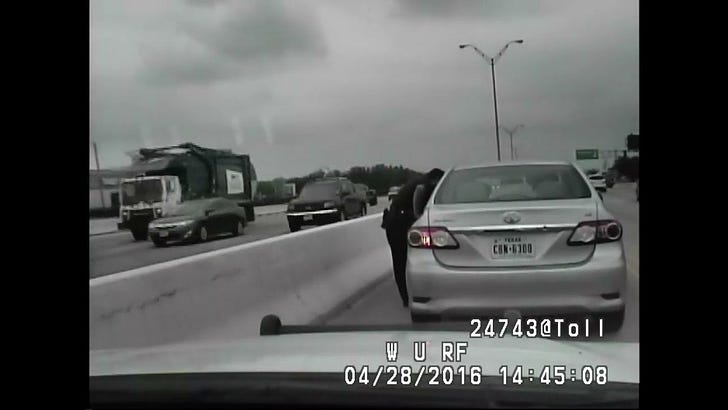Picture this: A police officer mistakenly makes a traffic stop without proper legal justification. As he approaches the car, he realizes he’s interrupted a child abduction. The driver suddenly hits the gas. The officer jumps onto the car and ultimately shoots the driver to stop him from continuing to drive. Is the shooting justified?
Now flip it. A man is sitting in his car, minding his own business. An unmarked vehicle pulls up. Two plainclothes officers jump out with guns drawn but don’t identify themselves as police. One of them stands in front of the car. Thinking he’s being carjacked, the driver panics and hits the gas. The officer in front of the car shoots through the windshield and kills the driver. Justified?
Hypotheticals of these sort were analyzed during oral arguments in Barnes v. Felix, a Supreme Court case that had the potential to better define the rights and responsibilities of police officers in deadly shootings. In a decision issued Thursday however, the Supreme Court largely punted, leaving the law unsettled.
The Court agreed to hear the case to answer a fairly straightforward question: Should courts judge a police officer’s use of deadly force based only on the “moment of threat,” those final seconds before the officer fires? Or should they consider everything that led up to the confrontation?
The facts of Barnes v. Felix are not complicated. Officer Roberto Felix pulled over Ashtian Barnes near Houston, Texas, for toll violations. Felix smelled marijuana in the car, and as he questioned Barnes, the driver suddenly attempted to flee. Officer Felix jumped onto the side of the vehicle and, within seconds, fired two shots, killing Barnes.
It was later discovered that Barnes had an illegal handgun in the car. A grand jury declined to indict Officer Felix, but the Barnes family sued in federal court.
The lower court, and later the Fifth Circuit Court of Appeals, sided with Officer Felix, applying the narrow “moment of threat” rule. They focused solely on those final seconds, deciding Felix could have reasonably believed he was in real danger while hanging onto the side of the car. But on Thursday, the Supreme Court unanimously said that wasn’t good enough. Writing for the Court, Justice Elena Kagan ruled that the “moment of threat” test was too limited. Courts must look at the “totality of the circumstances,” including events leading up to the shooting, not just the final seconds. The Court tossed out the Fifth Circuit’s decision and sent the case back for reconsideration under that broader standard.
Here’s the twist: the Court avoided the more controversial issue that’s divided lower courts, the concept of “officer-created danger.” That’s the theory that if an officer’s own actions recklessly create a dangerous situation, they may forfeit the right to use deadly force, even if they later face a real threat. The Ninth and Tenth Circuits have embraced this theory. Other circuits have not. That split remains unresolved. At oral argument, this was clearly what Officer Felix’s lawyers were most concerned about. Felix’s attorney essentially conceded that “totality of the circumstances” was the proper standard but urged the Court to reject the “officer-created danger” doctrine. The Court declined to do so, instead leaving that question, arguably the most consequential, for another day.
Now the case returns to the lower courts, where Barnes’ attorneys will likely argue that Officer Felix created the danger by jumping onto the car and therefore forfeited his right to use deadly force. While it seems unlikely that the Fifth Circuit will adopt this theory, the question remains open. Still, even if the court did adopt that standard, Felix likely didn’t violate it. He jumped on the car to stop a fleeing suspect, which he was allowed to do. He then fired when he reasonably feared for his life, which was also permitted. In any case, Felix himself is almost certainly not in real legal jeopardy as he is likely shielded by qualified immunity and would almost certainly be indemnified by the county.
The real danger, however, isn’t to Officer Felix, it’s to police across the country, especially in the Ninth and Tenth Circuits. The “officer-created danger” rule still stands, leaving law enforcement in legal limbo. Scores of police organizations warned the Supreme Court that keeping this rule alive would lead courts to second-guess officers’ split-second decisions to use deadly force, making the job more dangerous and more difficult. It will make them, literally, gun-shy. And now, that’s exactly where things stand.
Ashtian Barnes did not need to die, and yes, we can imagine rare situations where an officer creates the risk that leads to a shooting. But this case does not appear to be one of them. Far more definitive a threat is the continued whittling away of the authority we’ve entrusted to law enforcement. Allowing courts to retroactively strip a police officer of the right to use deadly force because of an earlier mistake does not promote public safety. The Supreme Court should have eliminated the rule.



